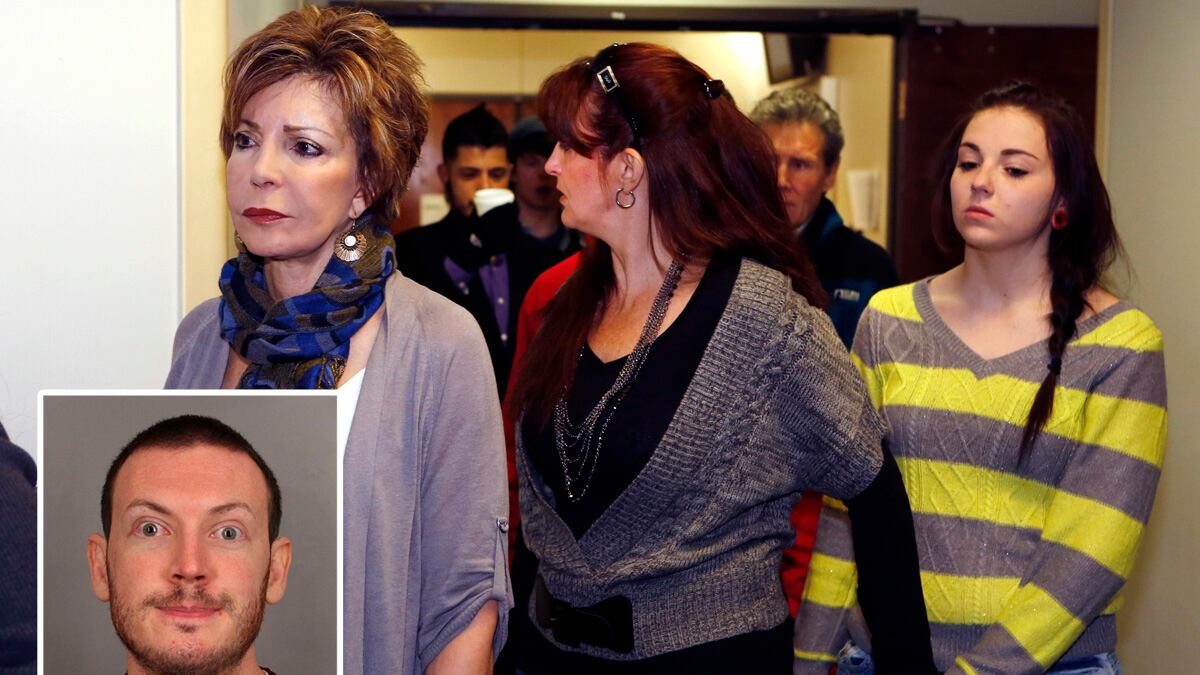Just minutes after he arrived at the Century 16 movie theater, Justin Grizzle, a patrol specialist with the Aurora Police Department and former firefighter and paramedic, walked into an unimaginable scene.

“There were several bodies laying motionless,” Grizzle said during testimony today. “Some of the officers were trying to carry some of the critical out. Gunshot victims were helping themselves and trying to crawl out. Others were being dragged out.”
As the smell of tear gas wafted through the air, more than 200 bullet casings and magazines littered the floor. Grizzle saw popcorn caked in blood, a thick slippery pool of blood by the exit, and the eerie sound of multiple cellphones ringing unanswered in the background. Grizzle made a decision that he needed to act fast.
“After realizing the severity, I made a decision I needed to take some of the victims out now,” he said softly, fighting back tears. “I didn’t want anyone else to die.”
Once he exited the 415-seat theater, Grizzle told a heavily guarded courtroom packed with reports and victims’ families, he used his patrol car as a makeshift ambulance to drive wounded moviegoers to nearby hospitals.
Grizzle transported Ashley Moser and her husband to the hospital first, he recalled. As Moser lay in the back seat of the car with another officer, her husband, also badly wounded, repeatedly asked for his 6-year-old daughter, Veronica, who had also been in the theater. “He wanted me to turn around,” said Grizzle. “He tried to open the door and jump out. I had to hold him down to keep him in the car.” Veronica later died from multiple gunshot wounds.
After he dropped off the Mosers, Grizzle said he picked up two more people “covered in blood and screaming.” Grizzle told the riveted courtroom that the victims were so caked in blood that he couldn’t tell if they were male of female.
Grizzle broke down again when he described driving Caleb Medley, an aspiring comedian, to the hospital. “I thought he was going to die,” he said. “I kept saying, ‘Don’t fucking die on me.’ He was making a god awful noise and when I heard that I would keep yelling.”
After shuttling seven wounded moviegoers to the hospital, Grizzle said his car was covered in blood—on the floors, ceiling, seats, and dashboard. “As I was making turns … I could hear it sloshing in the back of my car,” he said.
Grizzle was one of the officers who testified in Courtroom 201 on the first day of the preliminary hearing in the case against James Holmes, who is accused of killing 12 people and injuring 70 others on July 20 in a shooting spree at the midnight showing of The Dark Knight Rises in Aurora. Police say Holmes, with his hair dyed red as a creepy homage to Batman’s Joker, was dressed in combat gear and armed with an assault rifle, a Glock pistol, a shotgun, and two canisters of what sources say was tear gas.
Holmes went on his rampage one month after he withdrew from the Ph.D. program after failing a year-end exam, authorities say. On that day, he bought an AR-15 semiautomatic rifle to add to his collection of weapons.
Monday’s hearing was the first time that details of Holmes’s alleged rampage have been made public.
Holmes, wearing a red jumpsuit and shackled at the wrists and feet, sat like a zombie next to his team of public defenders during the beginning of the proceedings, which are expected to last a week. Sporting a brown bushy beard, the 25-year-old former University of Colorado Denver neuroscience doctoral student occasionally peered toward photos of the inside of the movie theater on a television screen. But mostly he sat up straight, staring ahead as three Arapahoe County sheriffs deputies monitored him closely.
Outside the courtroom, armed officers dressed in green fatigues and carrying binoculars scanned the immense parking lot. During breaks, swarms of cameras and photographers took quick snapshots of the victims’ family members as they walked by with their heads down. Each attendee was patted down by deputies looking for electronics, which are banned in District Judge William Sylvester’s courtroom.
Shortly before Grizzle began his makeshift ambulance route, Aurora police officer Jason Oviatt received a call that officers were needed at the back of the theater. There, Oviatt followed a trail of blood that led him to a white two-door sedan parked outside the exit near theater 9. He saw a man standing on the other side of the car, his hands on the roof and wearing a gas mask and a helmet.
Oviatt testified that he initially thought the man, later identified as James Holmes, was a police officer, because a radio call had been transmitted requesting that officers come prepared to the scene with gas masks. He realized he was face-to-face with the alleged mass shooter only when he noticed that Holmes’s gear was not standard police issue.
“It was about 20 feet when I realized he was not a police officer and I put him at gunpoint,” Oviatt testified. “He immediately put his hands up. He didn’t say anything.”
Oviatt said he told Holmes to get on the ground—and discovered he was outfitted in body armor from head to toe. “I could feel he was wearing soft armor like a police officer would wear,” said Oviatt. After Holmes was handcuffed, Oviatt discovered a handgun with a green laser on the roof of the car. As more officers arrived, they discovered a rifle case as well as a handgun inside the vehicle.
During a later search, Oviatt said, Holmes, who was dripping with sweat and smelled badly, was completely compliant. “There wasn’t even normal tension with him,” Oviatt recalled. “He would do what he was told. Ordinarily when you move someone around there is muscular tension. In his case he was very, very relaxed. He seemed very detached from it all.”
Officer Aaron Blue told the courtroom that he arrived at the back of the theater as Holmes was being handcuffed by Oviatt. Holmes, who had previously been silent, told Blue when questioned that he was carrying four weapons and he acted alone. Blue said Holmes offered up that his apartment was booby-trapped with IEDs. “He said he didn’t have any bombs here but he did at his home, and they wouldn’t go off unless we set them off,” testified the blond-haired Blue. “He used the term ‘improvised explosive devices.’”
As the chaos continued, detectives were dispatched to nearby hospitals and a local high school to speak to victims while others tended to the dead. Aurora Police Department Det. Todd Frederickson was one of the detectives tasked with interviewing the injured. Frederickson testified that the following day he interviewed Adan Avila in his hospital bed. Avila, who was wounded in the right leg and left arm, told the detective that Holmes was targeting “people who were fleeing.” He said he was helped out of the theater by his friends and “his leg bones were sticking out everywhere.”
Frederickson said he later spoke to 23-year-old Farrah Soudani, who was recovering at a local hospital. Soudani told the detective that she hit the floor when she heard the shots and then stood up when the pops stopped. That’s when she turned and was hit in the right side. “She coughed and saw several of her organs spilling out of the right side of her body,” he testified. Soudani told Frederickson that an officer was holding her organs inside her as she was taken to the hospital.
More detectives poured over hundreds of hours of surveillance videotape. In some of the tapes, detectives saw Holmes, who purchased his ticket in advance on July 8, enter the theater just after midnight. He began firing shortly after that.
Holmes, who has not yet entered a plea and has made at least one suicide attempt by running headfirst into a cell wall, has been charged with 166 counts of first-degree murder and attempted murder and possession of explosive devices.
Holmes’s defense team, which has repeatedly suggested that the wiry former student suffers from mental illness, is planning to call at least one mental-health expert, and will undoubtedly take the position that Holmes was insane at the time of the shooting and can’t be found guilty of the heinous crimes.
Whether that argument will be persuasive enough to avoid a trial is unlikely. What’s more likely is a plea deal. Meanwhile, Holmes is expected to sit in court throughout the week, zombielike, as prosecutors reveal more grisly details from the massacre.




